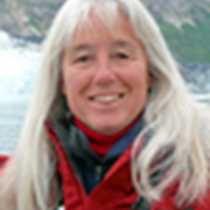Tracy Arm and Sand Bay
The National Geographic Sea Bird cruised south from Juneau and entered the Tracy Arm-Ford’s Terror wilderness area early this morning. Tracy Arm is a classic fjord— carved by glaciers and filled with sea water—narrow, twisting and deep. Sheer rock walls rise thousands of feet directly from sea level.
We enjoyed a morning of magnificent scenery as we made our way toward the end of the fjord, where it splits, each finger leading to the face of a tidewater glacier that spills from the mountains of the Coast Range all the way to the sea. We chose the north finger to explore by Zodiac this morning. We maneuvered around icebergs, keeping a look-out for mother harbor seals with their pups, which have been born within the last few weeks. Soon they will be weaned and on their own.
The Sawyer Glacier was active today, with bits and blocks and cascades of ice falling from its face into the water below. We remained at a safe distance to observe, and we listened to the sounds of the interactions between ice, liquid water and rock. Arctic terns performed aerial displays. Bare rock and rubble left behind by the retreating glacier provide nesting habitat for these birds.
Nimble and sure-footed, four mountain goats climbed upward after a visit to sea level. The group included a young kid, born earlier this spring. Hesitant at times, it managed to keep up with its more experienced companions.
The weather continued to improve throughout the day. The afternoon was filled with various shipboard activities as we retraced our wake back down the fjord. In the late afternoon, we anchored the vessel in Sand Bay and took the opportunity for a short introductory excursion to shore. Some people chose to explore via kayak, others walked through the forest and meadows full of colorful wildflowers.
In keeping with the Lindblad/National Geographic spirit of exploration and adventure, Justin (Photo Instructor/Undersea Specialist/Naturalist) donned a dry suit and SCUBA tanks to document, by video camera, the life below the surface at a new dive location. The chilly Alaskan waters are surprisingly rich, with many species of fish, invertebrates and marine algae (kelp). This site was not disappointing; a precipitous rock wall held numerous anemones, sea stars, and even a sea pen.
On the eve of the summer solstice, there was plenty of light after dinner for some whale watching in Stephens Passage. Pastel colors highlighted fluffy clouds and surface water patterns, but the first humpback whales of the trip stole the show. It was a beautiful way to culminate the first day of our expedition.




